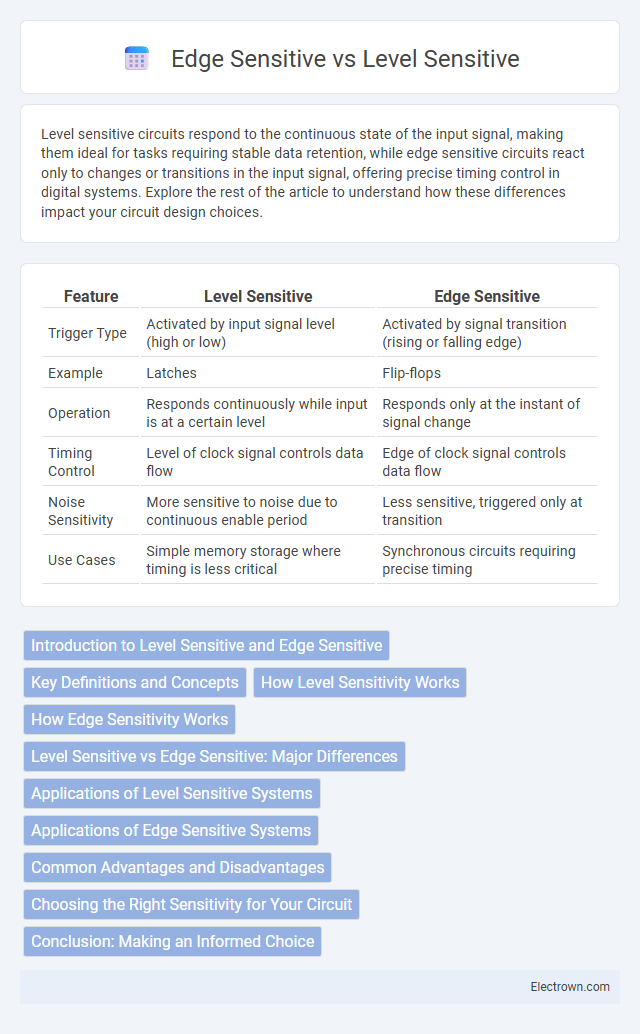Level sensitive circuits respond to the continuous state of the input signal, making them ideal for tasks requiring stable data retention, while edge sensitive circuits react only to changes or transitions in the input signal, offering precise timing control in digital systems. Explore the rest of the article to understand how these differences impact your circuit design choices.
Table of Comparison
| Feature | Level Sensitive | Edge Sensitive |
|---|---|---|
| Trigger Type | Activated by input signal level (high or low) | Activated by signal transition (rising or falling edge) |
| Example | Latches | Flip-flops |
| Operation | Responds continuously while input is at a certain level | Responds only at the instant of signal change |
| Timing Control | Level of clock signal controls data flow | Edge of clock signal controls data flow |
| Noise Sensitivity | More sensitive to noise due to continuous enable period | Less sensitive, triggered only at transition |
| Use Cases | Simple memory storage where timing is less critical | Synchronous circuits requiring precise timing |
Introduction to Level Sensitive and Edge Sensitive
Level sensitive and edge sensitive refer to two fundamental types of digital signal triggering used in electronics and digital circuits. Level sensitive circuits respond to the signal's voltage level, maintaining output as long as the input remains at a specified logic level, whereas edge sensitive circuits trigger actions only at the transition edges of the signal, either rising or falling edges. Understanding the differences between level sensitive and edge sensitive mechanisms is crucial for designing reliable flip-flops, latches, and timing circuits in digital systems.
Key Definitions and Concepts
Level sensitive circuits respond to the input signal's voltage level, maintaining output as long as the input remains at a specific logic level, commonly used in latch designs. Edge sensitive circuits trigger output changes only on specific transitions of the input signal, such as rising or falling edges, which is essential for flip-flop operation and synchronous digital systems. Understanding the distinction is crucial for timing analysis in digital circuits, where level sensitivity allows continuous monitoring while edge sensitivity enables precise control of data at clock edges.
How Level Sensitivity Works
Level sensitivity triggers a response whenever the input signal maintains a particular logic level, either high or low, during the entire clock period, allowing continuous data flow as long as that level is present. Unlike edge sensitivity, which responds only at the transition points of the clock signal, level-sensitive designs monitor sustained logic states to determine output changes. Your digital circuit's behavior depends on this constant evaluation of the input level, making timing analysis critical for ensuring reliable data latching.
How Edge Sensitivity Works
Edge sensitivity triggers a response precisely when a signal changes state, either from low to high (rising edge) or high to low (falling edge), ensuring accurate timing in digital circuits. This mechanism captures events only at the moment of transition, preventing false triggering during steady states. Your digital design benefits from edge sensitivity by reliably detecting changes without ambiguity in signal levels.
Level Sensitive vs Edge Sensitive: Major Differences
Level sensitive circuits respond to the duration of an input signal's state, maintaining output as long as the input remains at a particular logic level (high or low). Edge sensitive circuits, on the other hand, detect transitions or changes in the input signal, triggering output only at the rising or falling edge of the input waveform. The major difference lies in their timing dependency: level sensitive circuits depend on input duration, while edge sensitive circuits rely on signal transitions for operation.
Applications of Level Sensitive Systems
Level sensitive systems are commonly used in analog-to-digital converters where continuous monitoring of input voltage levels is critical for accurate output. They play a vital role in memory devices such as latches, where data is stored and maintained as long as the control signal remains at a certain level. Industrial control systems also benefit from level sensitive designs by providing stable operation in processes that require real-time response to varying sensor inputs.
Applications of Edge Sensitive Systems
Edge sensitive systems are widely used in digital circuits requiring precise timing control, such as flip-flops and registers in microprocessors where data must be captured on specific clock edges. These systems excel in synchronous designs, ensuring reliable data transfer and minimizing timing errors in sequential logic. Your projects involving high-speed communication or clocked storage elements benefit significantly from the predictable behavior of edge sensitive devices.
Common Advantages and Disadvantages
Level sensitive circuits offer simpler design and easier testing due to their continuous response to input signals, but they may suffer from glitches and unintended latching. Edge sensitive circuits provide precise timing by responding only at signal transitions, reducing timing errors but increasing design complexity and power consumption. You must consider the trade-off between timing accuracy and design simplicity when choosing between level sensitive and edge sensitive components.
Choosing the Right Sensitivity for Your Circuit
Choosing between level sensitive and edge sensitive circuits depends on the specific timing requirements and signal characteristics of your application. Level sensitive circuits respond to the voltage level of the input signal, suitable for continuously monitored signals, while edge sensitive circuits trigger actions only on signal transitions, ideal for capturing precise events. Selecting the right sensitivity type ensures accurate data processing and optimal circuit performance in synchronous digital designs.
Conclusion: Making an Informed Choice
Choosing between level sensitive and edge sensitive triggering depends on the specific application requirements for timing precision and noise immunity. Level sensitive circuits excel in environments where signal durations vary but require stable monitoring. Edge sensitive designs are preferred for capturing precise transition moments, reducing susceptibility to glitches in fast digital systems.
Level Sensitive vs Edge Sensitive Infographic

 electrown.com
electrown.com